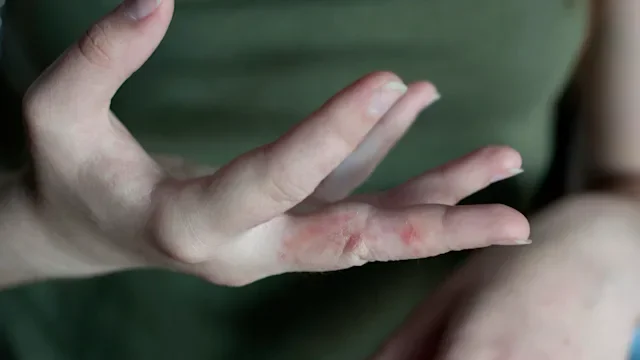Key takeaways:
Nail bed infections are very common. Most of the time they’re minor and easily treated.
Nail bed infections that have pus bumps or blisters can be more serious and require medical attention.
Nail infections are treatable. Warm soaks, medications, and surgical drainage are treatment options. You can reduce the risk of nail infection by not sharing nail grooming tools, avoiding nail trauma, and keeping hands and feet clean and dry.
Infection of the skin around the nail (called paronychia) is one of the most common medical conditions of the hand. This usually happens when the cuticle (a thin fold of skin around the nail) gets disrupted, allowing germs to get in and cause an infection. The cuticle normally keeps germs (bacteria, viruses, and fungi) from invading the underlying tissues. But trauma to the skin fold can cause infection. It can happen spontaneously, too.
Recognizing the signs of infection can help differentiate it from other nail conditions, like squamous cell cancer or psoriasis. Having the right diagnosis is important so you can get proper treatment for your nail bed condition. Let’s take a closer look at what an infected nail bed looks like.
What does an infected nail bed look like?
Infected nail beds can look different depending on what’s causing the infection and how long the infection has been developing. Early in an infection, changes may be barely noticeable or very mild. As the infection develops, changes may be more dramatic and present more symptoms. Some of the most common symptoms of a nail bed infection include:
Swelling around the nail
Red or violet discoloration at the nail fold, which can extend down the finger or toe
Pain and tenderness
Pus- or fluid-filled blisters
Loss of cuticle
Discoloration of the nail (white, yellowish, or brown)
Nail ridging or detachment
Search and compare options
Nail bed infection pictures
Here are some pictures to help you identify signs of a nail bed infection.




How can you tell if a nail bed infection is bacterial, fungal or viral?
Your healthcare professional can usually diagnose the cause of your nail infection based on your medical history and a physical exam. Some helpful factors to consider include:
History of the inflammation: Bacterial and viral nail bed infections usually come on suddenly and get worse quickly. Fungal infections develop slowly and can last for weeks to months.
Physical exam: Bacterial and viral paronychia are usually red and painful. They may have pus bumps. They usually only involve one finger or toe. Fungal nail bed infections are usually not very painful and often involve more than one finger or toe.
Risk factors: Nail biting and picking at hangnails are more likely to result in a bacterial infection. Regular wet work (like dishwashing) is more likely to lead to fungal infections.
Skin culture: A lab can check a sample of the nail or blister fluid for germs. This is useful if the infection gets worse despite treatment, or if it doesn’t improve as expected.
How do you get rid of an infected nail bed?
Treating paronychia depends on what’s causing the infection and how severe the symptoms are. Your dermatologist might recommend treatments like:
Warm soaks with soap and water 3 to 4 times a day.
Antibiotics, like amoxicillin-clavulanic acid (Augmentin), clindamycin (Cleocin), or Cephalexin (Keflex)
Antifungal medications, like terbinafine and itraconazole
Surgical treatment (such as abscess drainage)
Will a nail bed infection go away on its own?
Sometimes a nail infection may go away on its own — especially if it’s a minor bacterial or fungal infection. You should seek medical care for paronychia treatment if you have:
Severe pain, redness, or swelling
Drainage or bleeding from the area of infection
Fever
Read more like this
Explore these related articles, suggested for readers like you.
Nail bed infections can be more serious in some people. It’s less likely that a paronychia will go away on its own if you have any of these conditions:
What else can cause nail bed changes besides paronychia?
Not all changes in nail beds are caused by infection. Other medical conditions can cause nail changes, too. Some medical conditions that might cause nail bed changes include:
Psoriasis
Cancer
Thyroid conditions
Heart conditions
Lung disease
Vascular disease
The bottom line
Nail bed infections are common and can be quite painful. Fortunately, most nail bed infections are minor and easily treated. Some may even go away on their own without any treatment. More serious infections may need antibiotics or surgical drainage to treat them.
If you have nail bed infection symptoms — like severe pain, redness, swelling, drainage, or fever — you should seek medical attention right away. Your healthcare professional can help guide you on next steps for effectively treating your nail bed.

Why trust our experts?



Images used with permission from VisualDx (www.visualdx.com)
References
American Academy of Dermatology Association. (n.d.). 12 nail changes a dermatologist should examine.
American Osteopathic College of Dermatology. (n.d.). Paronychia nail infection.
Dulski, A., et al. (2023). Paronychia. StatPearls.
Familydoctor.org. (2018). Paronychia. American Academy of Family Physicians.
Relhan, V., et al. (2022). Acute and chronic paronychia revisited: A narrative review. Journal of Cutaneous and Aesthetic Surgery.
Rockwell, P. G. (2001). Acute and chronic paronychia. American Family Physician.


















